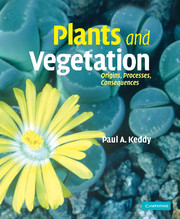Book contents
- Frontmatter
- Contents
- Preface
- Acknowledgements
- Chapter 1 Plants and the origin of the biosphere
- Chapter 2 Description of vegetation: the search for global patterns
- Chapter 3 Resources
- Chapter 4 Stress
- Chapter 5 Competition
- Chapter 6 Disturbance
- Chapter 7 Herbivory
- Chapter 8 Positive interactions: mutualism, commensalism, and symbiosis
- Chapter 9 Time
- Chapter 10 Gradients and plant communities: description at local scales
- Chapter 11 Diversity
- Chapter 12 Conservation and management
- Questions for Review
- References
- Index
- References
Chapter 3 - Resources
- Frontmatter
- Contents
- Preface
- Acknowledgements
- Chapter 1 Plants and the origin of the biosphere
- Chapter 2 Description of vegetation: the search for global patterns
- Chapter 3 Resources
- Chapter 4 Stress
- Chapter 5 Competition
- Chapter 6 Disturbance
- Chapter 7 Herbivory
- Chapter 8 Positive interactions: mutualism, commensalism, and symbiosis
- Chapter 9 Time
- Chapter 10 Gradients and plant communities: description at local scales
- Chapter 11 Diversity
- Chapter 12 Conservation and management
- Questions for Review
- References
- Index
- References
Summary
Resource acquisition as one logical starting point for plant ecology. The CHNOPS perspective. Costs of acquisition. The global carbon pool. Harvesting photons. Canopy architecture. Photosynthetic types (C3, C4, CAM). Height. The search for below-ground resources. Water. Algae in fresh water. Phosphorus. Nitrogen. Fertilization experiments. Resources in space and time. Gradients and patches. Conceptual classification of resources. Complications of resource fluctuation. Chronic scarcity of resources. Stress tolerance. Plants in tropical canopies, succulents, carnivorous plants, parasitic plants. Nutrient conservation. Soils. Some history. Humans and soil resources. Synthesis.
Introduction
The CHNOPS perspective
Plants, like all living organisms, comprise relatively few elements (Table 3.1). Morowitz (1968) has therefore described the Earth-based life forms as CHNOPS organisms. These six elements could thus be considered the fundamental resources for ecologists to study. Organisms do not use these elements in equal amounts. Table 3.2 shows that oxygen and carbon predominate, whereas sulfur and phosphorus make up less than 1 percent of organisms.
These elements are not equally available in time or space. In order to grow and reproduce, plants must forage for, absorb, and internally transport such resources before being able to construct new tissues. They also face the challenges of conserving such resources when they are in short supply. While it is true that all life forms must go through similar steps, vascular plants face a situation very different from most other life forms.
- Type
- Chapter
- Information
- Plants and VegetationOrigins, Processes, Consequences, pp. 63 - 125Publisher: Cambridge University PressPrint publication year: 2007



